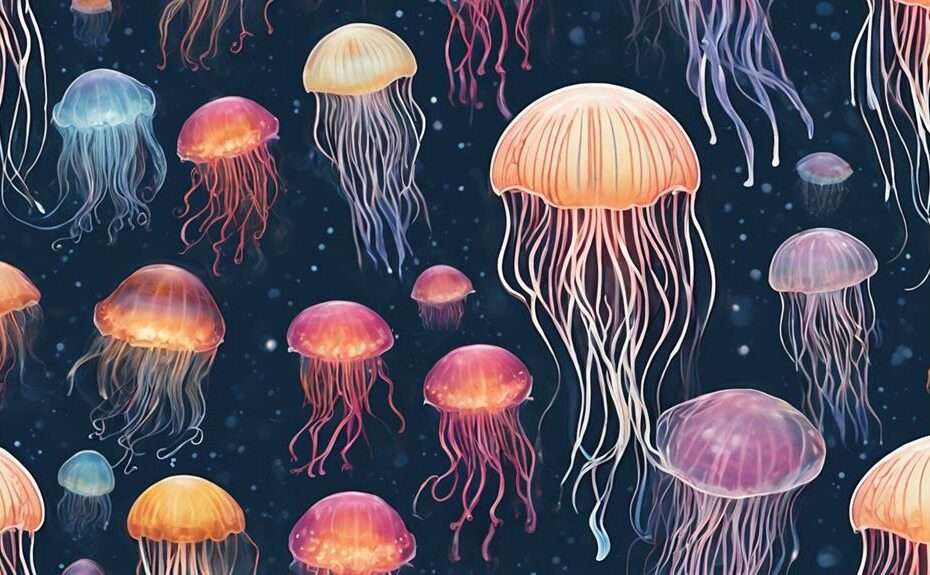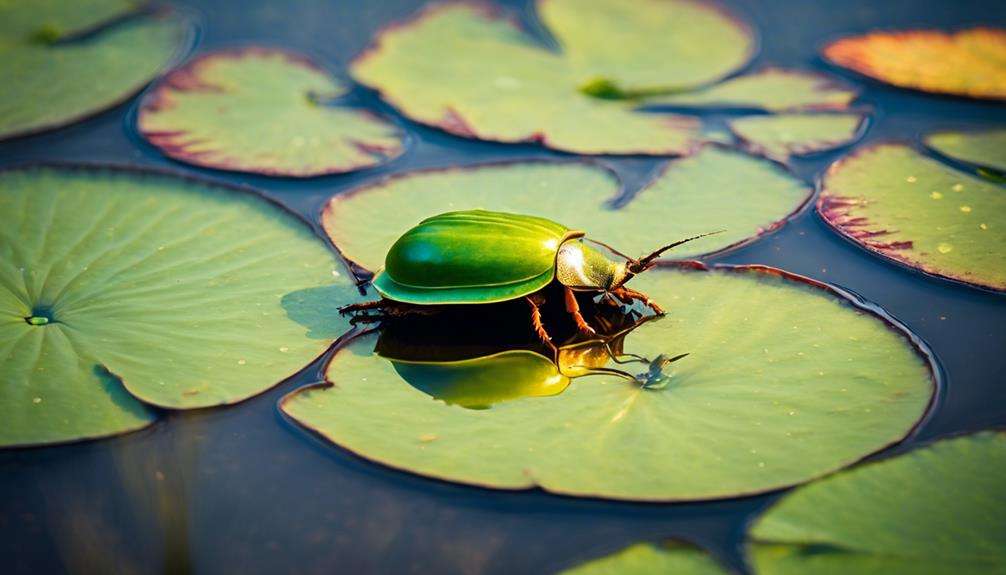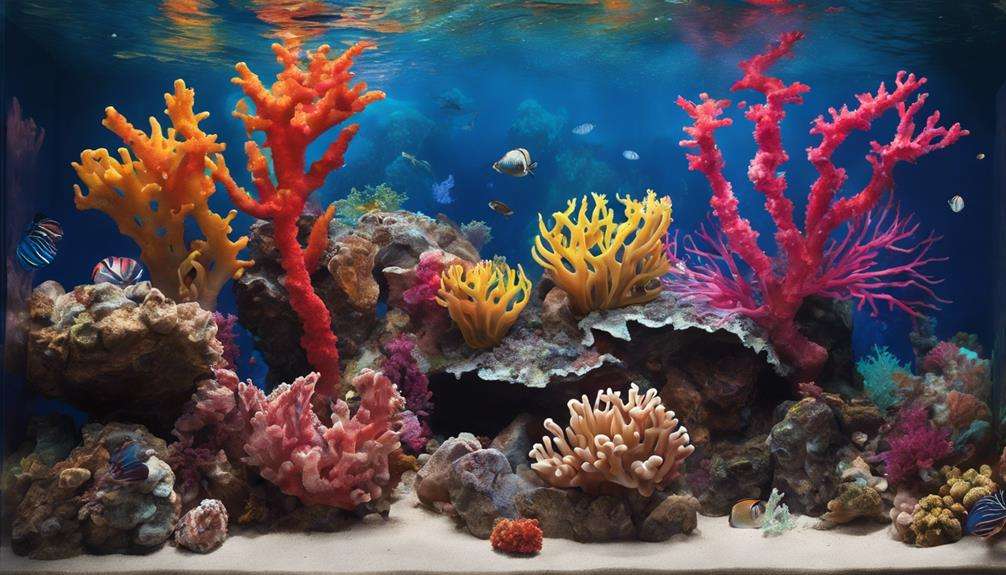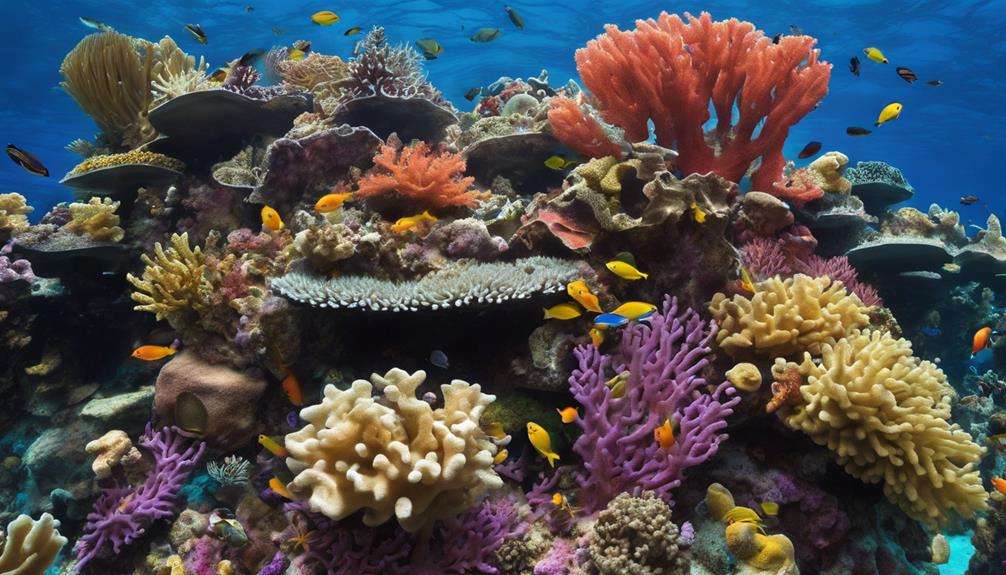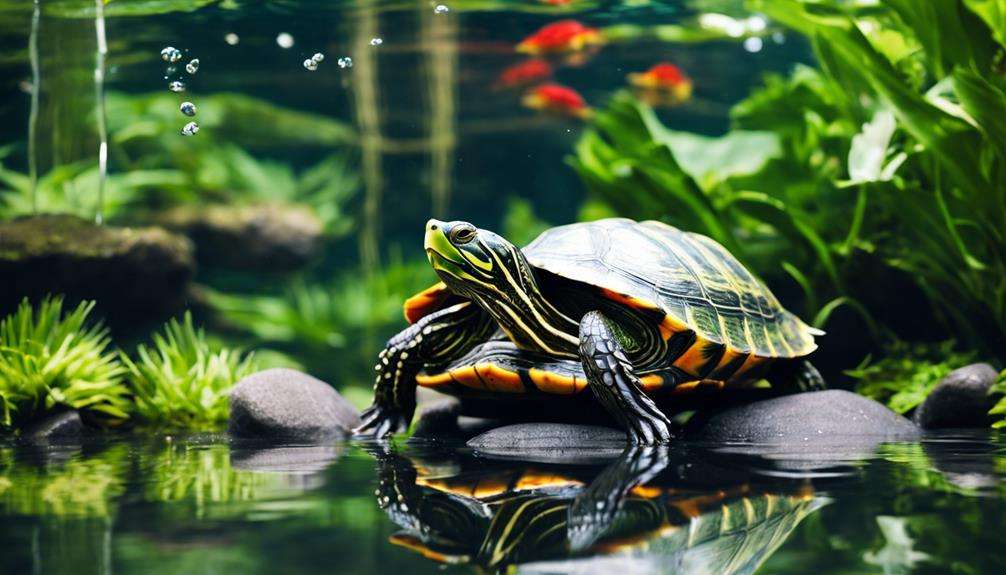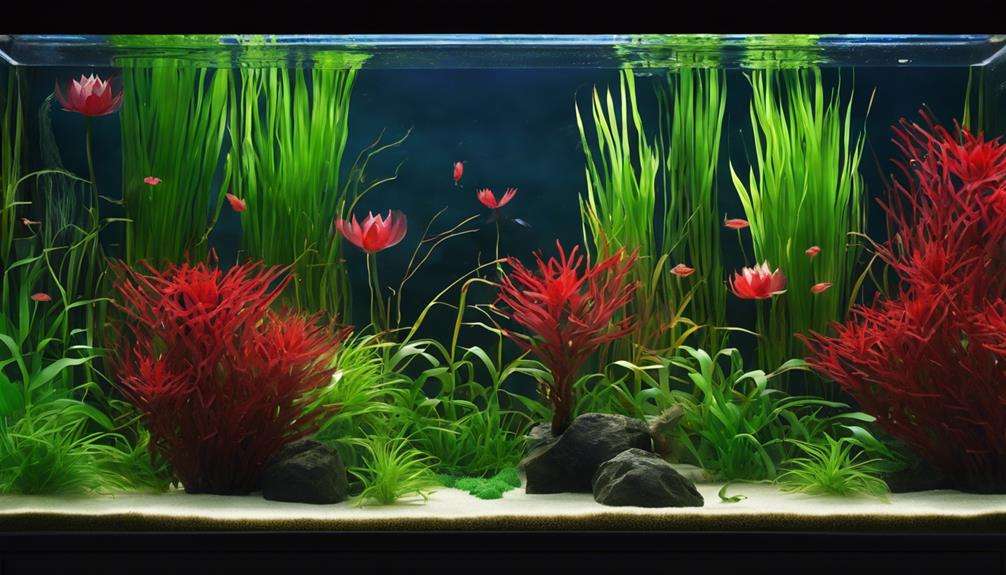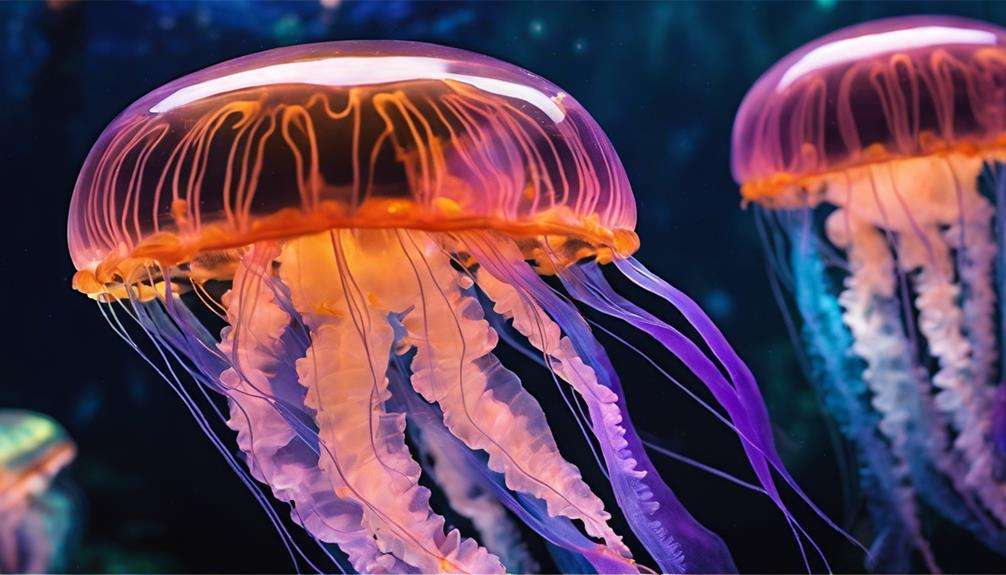If you're aiming to add a touch of otherworldly grace to your aquatic collection, exploring the domain of jellyfish varieties might just be the perfect next step. While moon jellyfish are a common choice, there exist lesser-known yet equally enchanting species that could elevate your underwater oasis.
From the elegant Lion's Mane to the mysterious Box Jellyfish, each species brings its own unique charm and challenges. Let's delve into the depths of the top jellyfish species for those intrigued by the wonders of the ocean.
Key Takeaways
- Moon Jellyfish and Lion's Mane Jellyfish are popular choices for their unique characteristics and care requirements.
- Upside-Down Jellyfish offer a fascinating symbiotic relationship with algae and gentle sting for enthusiasts.
- Australian Spotted Jellyfish, while captivating, pose challenges due to invasiveness and impact on local ecosystems.
- Understanding habitat, diet, and care needs of these jellyfish species is essential for a rewarding aquatic pet experience.
Moon Jellyfish Care Guide
When caring for Moon Jellyfish in your aquatic tank, it's essential to maintain stable water conditions within specific parameters to guarantee their well-being and health. One critical component in ensuring excellent water quality for Moon Jellyfish is a reliable filtration system. The filtration system helps in removing excess waste, uneaten food, and other impurities that could compromise the delicate balance of the tank environment. For Moon Jellyfish, a gentle water flow is preferable to prevent them from getting damaged by strong currents. Additionally, the filtration system aids in maintaining the required oxygen levels in the water, vital for the jellyfish's respiration.
To meet the needs of your Moon Jellyfish, invest in a high-quality filtration system that's suitable for the size of your tank. Regularly monitor and clean the filtration system to prevent clogs and ensure its efficient operation. By consistently maintaining your tank's filtration system, you can create a healthy and thriving environment for your Moon Jellyfish to flourish.
Lion's Mane Jellyfish Profile
The Lion's Mane Jellyfish, known scientifically as Cyanea capillata, boasts impressive tentacles that can extend up to 120 feet in length, making them a visually captivating species to observe in an aquatic setting.
Their vibrant coloration, ranging from deep red to orange hues, adds to their allure but belies the potent sting they possess, necessitating careful handling and consideration in tank environments.
Understanding their unique appearance features, habitat preferences, and dietary needs is essential for ensuring the well-being and safety of these majestic jellyfish in captivity.
Unique Appearance Features
With its flowing tentacles resembling a lion's mane, the Cyanea capillata, or Lion's Mane jellyfish, stands out for its distinctive appearance among aquatic species. These jellyfish are equipped with specialized stinging cells called nematocysts located on their tentacles, aiding in prey capture and defense.
The striking coloration of the Lion's Mane jellyfish, ranging from deep red to orange, adds to its allure as an aquatic pet. Their large size, with tentacles that can extend up to 120 feet, creates a visually enchanting display in aquariums.
When considering these jellyfish for your aquatic setup, it's important to note their unique appearance features, which not only contribute to their aesthetic appeal but also play a role in their biological filtration processes within their ecosystem.
Habitat and Diet
In the natural habitat of Lion's Mane jellyfish, located in cold Arctic waters and the North Atlantic and North Pacific oceans, they primarily feed on small fish, zooplankton, and other jellyfish species. These majestic creatures with their long trailing tentacles, equipped with stinging cells, capture prey like brine shrimp in the wild.
Lion's Mane jellyfish possess a distinctive bell-shaped body that can reach up to 8 feet in diameter, making them one of the largest jellyfish species. Their diet is essential for their survival, as they rely on the availability of various marine organisms to sustain their energy needs. Understanding their dietary requirements is vital for successfully caring for Lion's Mane jellyfish in captivity.
Care and Maintenance
Setting up an appropriate tank environment for Lion's Mane jellyfish entails meticulous attention to detail and specialized considerations to guarantee their well-being in captivity. Due to their long tentacles, a critical aspect of care is implementing specialized filtration systems to prevent entanglement. These systems help maintain water quality by removing debris and ensuring a safe environment for the jellyfish.
Adequate filtration also assists in creating a suitable flow rate within the tank, mimicking their natural habitat's gentle currents. When choosing a filtration system, opt for ones with fine mesh screens and low flow rates to safeguard the jellyfish from harm. By prioritizing proper filtration, you can assure a thriving and healthy environment for your Lion's Mane jellyfish.
Upside-Down Jellyfish Characteristics
Upside-down jellyfish, scientifically known as Cassiopea, exhibit a distinctive feeding behavior by lying inverted on the seafloor.
They form a fascinating symbiotic relationship with photosynthetic algae, which aids in their energy production through photosynthesis.
Despite having a mild sting that can cause irritation, these jellyfish are typically harmless to humans.
Unique Feeding Behavior
Efficiently capturing prey with their tentacles facing upwards, Cassiopea jellyfish exhibit a distinctive feeding behavior facilitated by symbiotic algae within their tissues. These unique jellyfish primarily feed on plankton and small invertebrates that drift into their tentacles.
Their upside-down position on the seafloor allows them to passively capture live brine and other prey as they float by. By hosting symbiotic algae, Cassiopea jellyfish benefit from the energy produced through photosynthesis, aiding in their nutrition.
The tentacles facing upwards enable them to efficiently obtain nutrients while conserving energy that would otherwise be spent on swimming. This feeding strategy showcases the remarkable adaptation of Cassiopea jellyfish to their environment, ensuring their survival in aquatic ecosystems.
Interesting Symbiotic Relationship
With a unique symbiotic relationship, Cassiopea jellyfish, also known as upside-down jellyfish, exhibit fascinating characteristics related to their interaction with photosynthetic algae. These jellyfish host beneficial zooxanthellae algae within their tissues, creating a safe environment for photosynthesis to take place.
Through this relationship, the algae produce essential nutrients through photosynthesis, aiding in the jellyfish's well-being. This mutually beneficial partnership enables upside-down jellyfish to thrive in shallow, sunlit waters, where sunlight is abundant for the algae to photosynthesize effectively.
The presence of zooxanthellae also imparts a brownish hue to these jellyfish due to the pigments within the algae. This intricate symbiotic bond showcases the remarkable adaptability and interconnectedness of marine organisms in their ecosystems.
Blue Blubber Jellyfish Overview
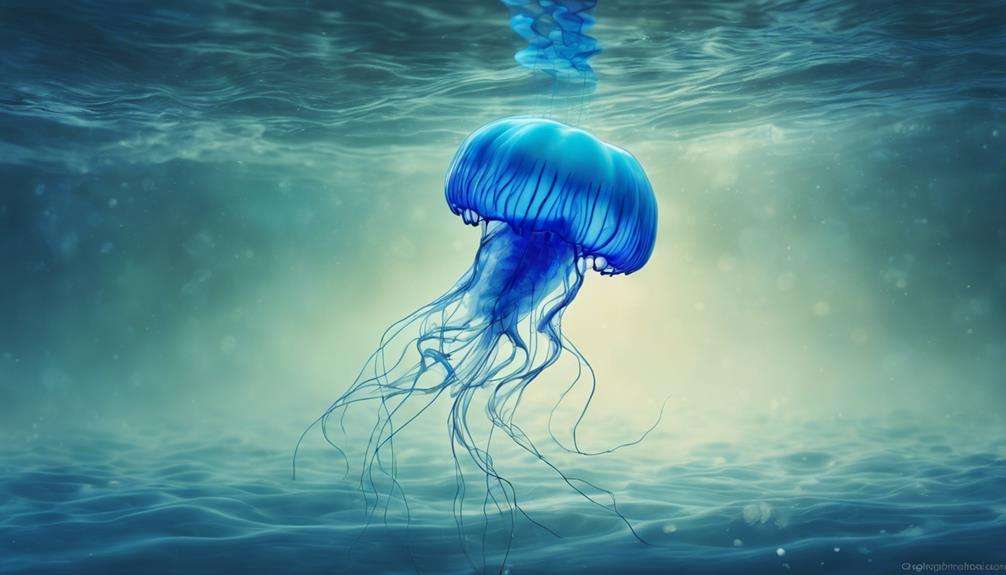
What distinguishes the Blue Blubber Jellyfish (Catostylus mosaicus) with regards to appearance and habitat characteristics?
Blue Blubber Jellyfish, also known as the 'Cabbage Head Jellyfish', are commonly found in the coastal waters of Australia and the Indo-Pacific region. These jellyfish are popular among aquatic pet enthusiasts due to their mild sting, making them suitable for beginners in jellyfish keeping.
They exhibit a distinctive blue coloration and have a dome-shaped bell, giving them a unique appearance in saltwater tanks. Blue Blubber Jellyfish are known for their gentle movements and peaceful nature when kept in aquariums, making them a fascinating addition for hobbyists.
Their striking blue hue adds a vibrant touch to any aquatic environment, and their tranquil behavior makes them a joy to observe. Overall, the Blue Blubber Jellyfish is a mesmerizing species that's both visually appealing and easy to care for, making it a fantastic choice for those looking to enhance their saltwater tank with these mesmerizing creatures.
Flower Hat Jellyfish Traits
Flower hat jellyfish, classified under the Olindias formosa species, exhibit a striking appearance characteristic of their species. These jellyfish, native to the Pacific Ocean, particularly around Japan, boast a unique translucent bell adorned with colorful tentacles resembling a floral pattern.
In their natural habitat, flower hat jellyfish play an important role in the nitrogen cycle, where they consume small marine organisms, excreting nitrogen-rich waste that contributes to the nutrient cycling in the ocean ecosystem.
Due to their venomous tentacles, which can cause mild to moderate stings in humans, caution is necessary when handling these mesmerizing creatures. While alluring, flower hat jellyfish aren't commonly kept in home aquariums due to their specialized care requirements and potential sting hazards.
Their beauty and importance in the ecosystem make them fascinating creatures to observe in the wild, where they thrive as part of the intricate marine food web.
Comb Jellyfish Care Tips
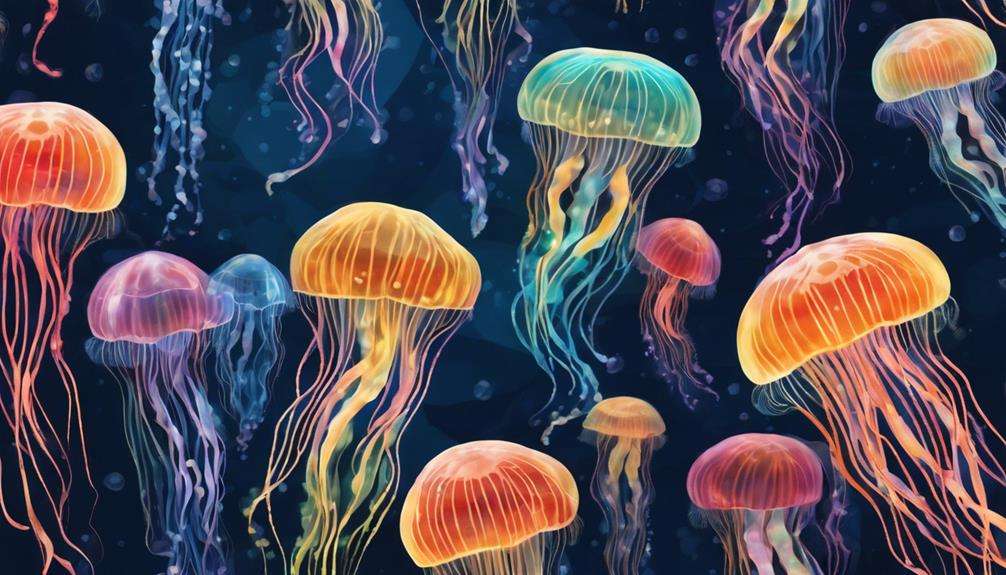
To guarantee high-quality care for comb jellyfish in your aquarium, meticulous attention to their delicate needs is essential. Comb jellyfish aren't true jellyfish but ctenophores, possessing a unique bioluminescent display that enhances the allure of your aquatic environment.
Due to their sensitivity to water conditions, maintaining pristine water quality is paramount. Regular water changes are important to guarantee a stable environment for these delicate creatures. Comb jellyfish require a gentle water flow in the tank to prevent any stress on their fragile bodies.
Additionally, feeding them live plankton or specialized jellyfish food is essential for their nutrition and well-being. When selecting tank mates, opt for peaceful species to avoid any potential aggression towards the passive comb jellyfish. By adhering to these care tips, you can create a suitable habitat that promotes the health and vibrancy of your comb jellyfish.
Box Jellyfish Species Highlights
Box jellyfish possess a unique cube-shaped bell and lengthy tentacles armed with potent venom, making them a formidable marine species.
Their intricate eyes, consisting of 24 eyes grouped into four clusters, provide them with remarkable visual capabilities.
Understanding their habitat preferences and agile swimming behaviors is essential for appreciating these fascinating yet dangerous creatures.
Box Jellyfish Characteristics
With their distinctive cube-shaped bell and venomous tentacles, box jellyfish stand out as a unique and potentially dangerous species among marine creatures. When considering caring for box jellyfish, it's important to replicate their natural habitat as closely as possible. Maintaining appropriate water temperature, salinity levels, and providing adequate space for swimming are essential aspects of their care.
Due to their highly toxic venom, handling box jellyfish should be done with extreme caution to avoid stings. Feeding these jellyfish a diet of small fish and shrimp is necessary to meet their nutritional needs. Additionally, regular water quality checks and tank cleanings are essential to ensure a healthy environment for box jellyfish.
Following these care guidelines diligently is important for successfully keeping box jellyfish as aquatic pets.
Venomous Properties Explained
When considering the remarkable venomous properties of box jellyfish species, a key highlight is their potent toxins targeting the heart, nervous system, and skin cells, posing significant risks to those who encounter them.
The venom of box jellyfish, such as Chironex fleckeri, contains complex mixtures of proteins and peptides that can induce excruciating pain, paralysis, and in severe cases, even death. These toxins act swiftly upon contact, disrupting normal physiological functions and leading to cardiovascular collapse or neuromuscular issues.
The specialized stingers called nematocysts on their tentacles inject venom upon skin contact, causing immediate and intense reactions. Due to the severity of their venomous nature, caution is essential when exploring waters where box jellyfish inhabit to prevent potentially fatal encounters.
Habitat and Behavior Insights
Inhabiting the warm waters of tropical and subtropical regions worldwide, box jellyfish, with their cube-shaped bells and long tentacles, have intriguing habitat preferences and behaviors.
These creatures are highly sensitive to changes in water quality, requiring vital conditions to thrive. Box jellyfish maintain their water quality by actively swimming to different depths where they can find suitable temperatures and salinity levels.
Additionally, they exhibit a unique behavior known as diel vertical migration, where they move closer to the surface at night to feed and descend to deeper waters during the day to avoid predators.
Understanding these habitat requirements and behavioral patterns is essential for those interested in keeping box jellyfish in captivity.
Red-Eyed Medusa Jellyfish Details
Red-Eyed Medusa Jellyfish, scientifically known as Polyorchis pencillatus, are notable inhabitants of the Pacific Ocean, distinguished by their distinct red eyespots located at the base of their tentacles. These jellyfish, while enthralling, aren't commonly found in the pet industry due to their specific care requirements and potential stinging capabilities.
Their transparent bell with red radial canals adds to their unique appearance, making them a fascinating species for marine enthusiasts. Red-Eyed Medusa Jellyfish primarily feed on small planktonic organisms, contributing to their delicate ecosystem role. Despite their beauty, these jellyfish are known to have a mild sting compared to other jellyfish species, which is an important factor to take into account for those interested in keeping them.
If you're contemplating these jellyfish as pets, have a thorough understanding of their needs and behavior to provide them with a suitable environment in captivity.
Arctic Lion Jellyfish Facts
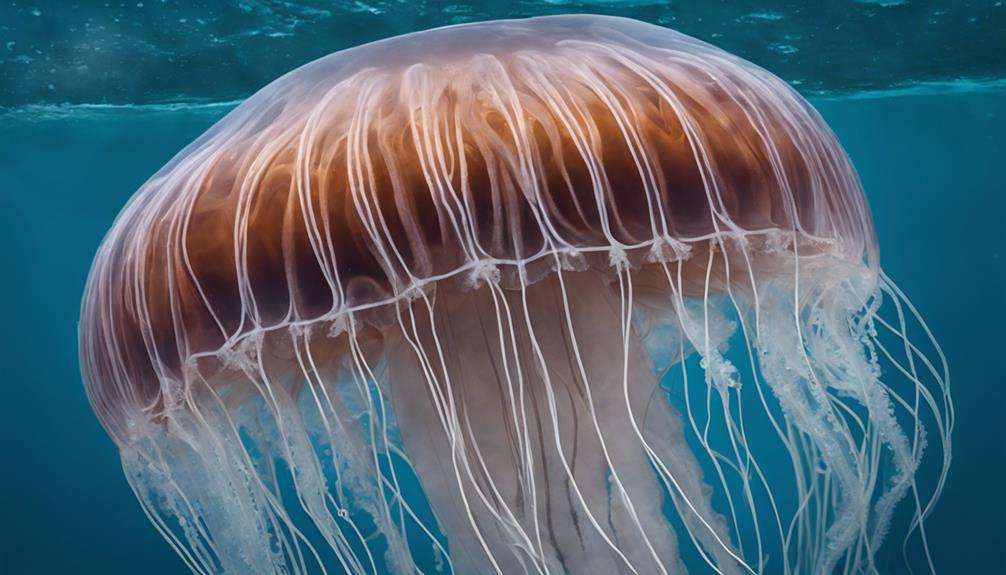
The Arctic Lion Jellyfish, scientifically referred to as Cyanea capillata, stands out as one of the largest jellyfish species globally, boasting bell diameters that can extend up to 8 feet and tentacles that reach over 100 feet in length. These majestic creatures exhibit a striking red or purple coloration and are equipped with long, flowing tentacles adorned with stinging cells. Found in the cold waters of the Arctic, North Atlantic, and North Pacific oceans, the Arctic Lion Jellyfish can deliver painful stings to humans, making them a potential threat to swimmers and divers.
When considering tank mates for the Arctic Lion Jellyfish, it's important to remember their predatory nature and powerful stinging capabilities. Due to these factors, it isn't recommended to house them with other jellyfish or delicate species that could be harmed by their tentacles. It's best to keep Arctic Lion Jellyfish in a species-specific tank to their well-being and prevent any potential harm to other aquatic creatures.
Australian Spotted Jellyfish Care
The care of Australian Spotted Jellyfish, known scientifically as Phyllorhiza punctata, requires attention to their unique ecological impact and dietary needs. As large jellyfish native to the South-West Pacific Ocean, Australian Spotted Jellyfish have distinctive spots on their bell and feed on zooplankton, small fish, and fish eggs.
When caring for these jellyfish, it's important to guarantee an appropriate diet that meets their nutritional requirements. Overfeeding should be avoided as uneaten food can lead to water quality issues in their habitat, affecting their overall well-being.
Due to their invasive nature and rapid population growth, Australian Spotted Jellyfish can have a significant impact on ecosystems and fisheries. Monitoring their feeding habits and promptly removing any uneaten food from their environment is essential to maintain a healthy and balanced ecosystem.
Understanding the dietary habits and ecological implications of Australian Spotted Jellyfish is fundamental in providing the best care for these fascinating aquatic creatures.
Frequently Asked Questions
What Are the Best Jellyfish to Keep as Pets?
When considering jellyfish care, thus choose species like Moon jellyfish or Aurelia aurita. They offer ease of maintenance and mesmerizing beauty. Blue Blubber jellyfish are hardy and visually striking, making them great choices for aquatic pet enthusiasts.
Are Jellyfish High Maintenance Pets?
Caring for jellyfish demands precision. You must monitor water quality diligently, ensuring stability for their well-being. Feeding them a carnivorous diet and maintaining ideal conditions like temperature and salinity are essential for their health.
Can I Keep Jellyfish as a Pet?
You can keep jellyfish as pets, but it requires specialized care. Make sure proper tank setup, consistent water quality, and temperature. Research feeding habits, growth patterns, and health issues. Comply with local regulations and commit to responsible ownership.
Can You Keep Golden Jellyfish as Pets?
You can keep golden jellyfish as pets, but it requires precise jellyfish husbandry. Maintaining their specialized needs like lighting and food sources is important. Their symbiotic relationship with algae gives them their unique golden-brown coloration.
Conclusion
Thus, for aquatic pet enthusiasts, moon jellyfish are a mesmerizing choice. Their care requirements, including stable water conditions and a carnivorous diet, make them relatively easy to care for.
With their bioluminescence and global distribution, moon jellyfish are truly fascinating creatures to observe. Consider adding these ethereal beings to your aquatic collection for a captivating and colorful display.
Delve into the world of moon jellyfish and discover the beauty they bring to your underwater environment.
